The factors that influence green speed
Related Articles
Members of golf clubs often want their greens to be faster but, before embarking on this quest, it is essential to understand the factors that affect green speed, what your target green speed might be and how to get there.
Here, Stella Rixon argues that improving pace is not as simple as cutting the grass shorter or rolling more.
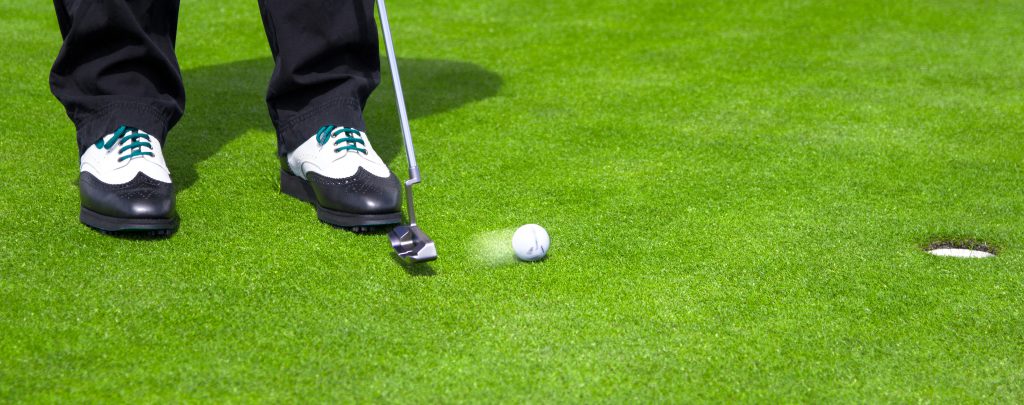
Be aware that although green speed is seemingly easy to measure, it can also be notoriously inaccurate. Accuracy will depend on the skill of the user, using a recognised standard operating method, with suitable Stimpmeter spots that should be used each repetition and in calm weather conditions (wind speed no more than 10mph). In windy conditions, readings should be taken under cover, which is not practical day-to-day. Therefore, comparing green speed figures taken at different sites, by different people, in different weather conditions, is likely to be meaningless.
However, measuring green speed on your own site for the purpose of understanding and improvement can be useful – more on that later.
What are the key factors affecting green speed?
The table shows the main aspects that will affect green speed. As you can see, top of the table in importance is the weather, which we have no ability to control.
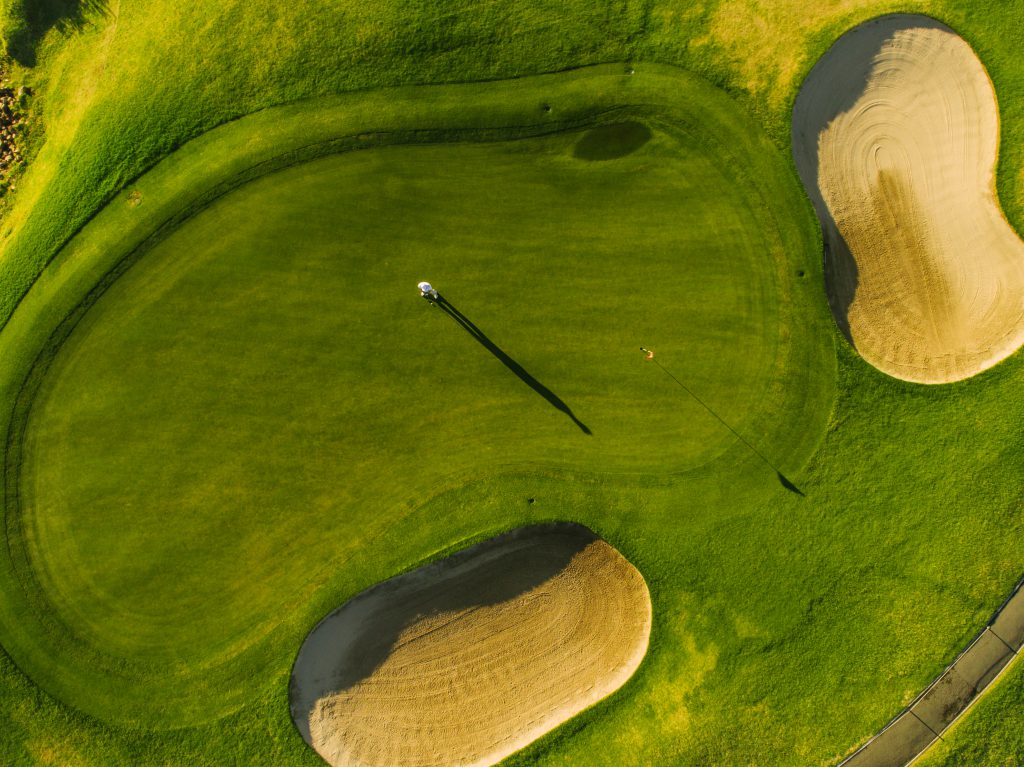
Environment
However, we can affect the ability of the greens to dry out by maximising drainage, air movement and light to the surfaces. This is also vital for the general health of your turf. To demonstrate this point, measure green speed (accurately) throughout the year on a green open to light and air, compared to one in a sheltered and shaded position, and you will soon appreciate the limitations of the green’s environment and what degree of variation is found on your course. There can easily be a foot difference between the wettest and driest greens on a course.
Therefore, a thorough assessment of the environment around each green is a good starting point. Increasing light availability from the east and south and opening up to the prevailing wind (usually from the south-west) should be your focus for selective tree / shrub removal. If tree work is not possible, then, if your budget allows, clubs can consider use of fans and lighting rigs. However, this is not attainable for most. In which case, a sheltered green will rely heavily on excellent drainage to give it any chance of drying out. Essentially, take all available action to improve the growing environments in an effort to naturally improve green speed.
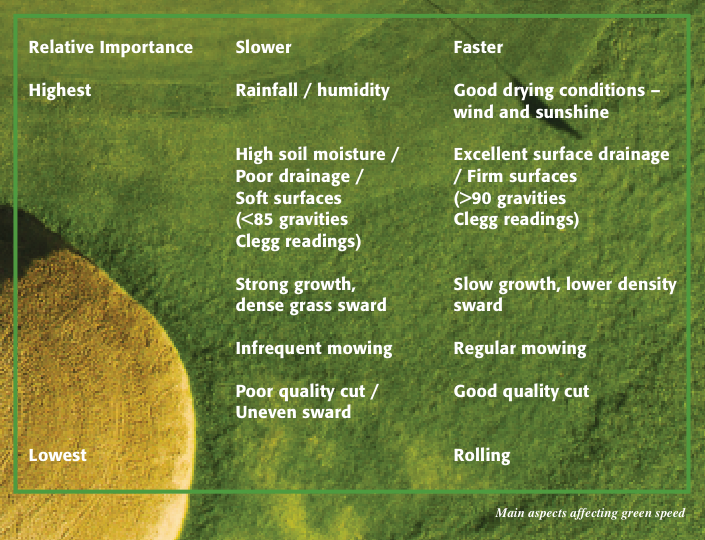
Firmness is the key
For year-round sustainable pace you need firm, dry surfaces which require good drainage. Very few UK greens have sufficiently high infiltration rates to be able to maintain moisture less than 30 per cent year-round. The majority are not blessed with well-drained soils and therefore need good surface run-off, light / air, soil improvement and control of organic matter levels (less than four per cent) through sand amelioration and, in many cases, installation of drainage systems.
Growth rate and density
Less is more when it comes to growth rate and sward density – a dense, green carpet of grass may look attractive to the uneducated eye but it certainly compromises green speed. High growth and density creates more friction or drag on the ball, slowing it down. A slow growing, lower density sward is preferable and will dry out more readily, so gaining a firmer, drier surface more rapidly after rainfall.
Fescue grasses, with their slow growth and needle-like rolled leaves, naturally produce a fine textured and unproductive sward. Which is why this grass species naturally produces surfaces of appropriate green speed and smoothness / trueness, without the need for intensive maintenance and high inputs. Unfortunately, the majority of greens are not dry enough to support this grass species and maintenance practices tend to be too aggressive, resulting in excessive disturbance pressure.
Instead, most courses are managing an annual meadow-grass (Poa annua) dominated sward with a component of browntop bent in drier greens. Annual meadow-grass has a folded, boat shaped leaf which presents more drag on ball roll compared to the flat leaves of bent or the rolled fescue needles. Annual meadow-grass also has a tendency for high density in moisture and nutrient rich environments and it is highly competitive in these conditions. Therefore, management should focus on improving the environment and drainage, as detailed above, and then carefully controlled use of fertiliser and water to prevent excess growth. You want to aim for a clipping rate of around one to one and a half empties of triple mower boxes from 19 greens (or one empty of hand mower every five to six greens) throughout the growing season to achieve good pace.
However, at times, wet and warm weather will inevitably create undesirable sward density and growth. In these instances, use mechanical means to thin the sward through verticutting. A desirable sward density is one where you can see space around individual grass plants and sand dressings should be visible at the turf base.
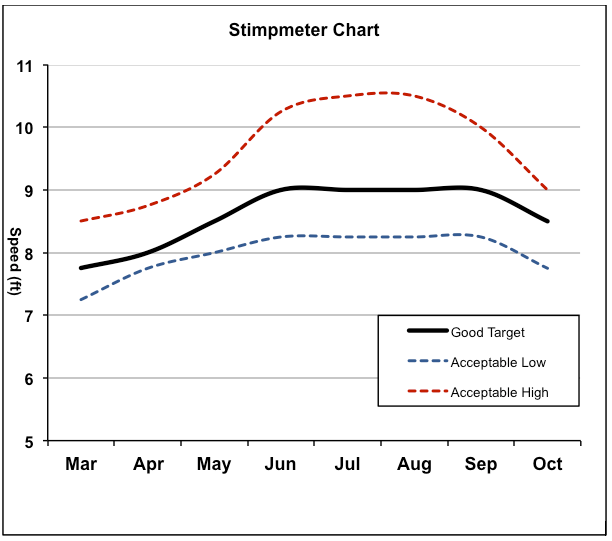
Mowing and rolling
Last on the list (but often the first to be considered) is mowing and rolling.
Regular mowing is required to maintain green speed. If greens remain wet for prolonged periods due to poor drainage and / or sheltered position and shade, then the surfaces will not be suitable for mowing for a large percentage of the autumn to spring period. Growth will make it necessary to cut the greens in less than ideal conditions and use of the mower on these soft surfaces causes wheel mark indentations, reducing smoothness / trueness and surface quality.
Quality of cut is important using modern machinery, correctly set up with sharp blades so that leaves cut cleanly. Regular grinding is recommended to keep blades sharp, particularly when topdressing regularly, as desired.
Lower cutting heights will generally give higher speeds, at least initially. However, cutting low (below 3.25mm) regularly will reduce rooting depth and promote dominance by annual meadow-grass, which is prone to seedheads, disease, drought and wear, all of which can lead to a loss of trueness and surface quality. Instead, it would be preferable to work towards creating a suitably firm, dry surface so that growth can be controlled by restricting soil moisture, aiming for less than 30 per cent in the upper 60mm. For greens that stay within this moisture range, a cutting height of 3.75-4mm (and even higher on dry sites) will produce suitably high green speeds.
Rolling improves speed, smoothness and trueness but it should really be a finishing tool – the icing on the cake if you like. Effects of rolling only last hours, not days. Therefore, rolling is not the answer to achieve prolonged pace and use of a roller on wet soils will cause deterioration of turf health and should be avoided.
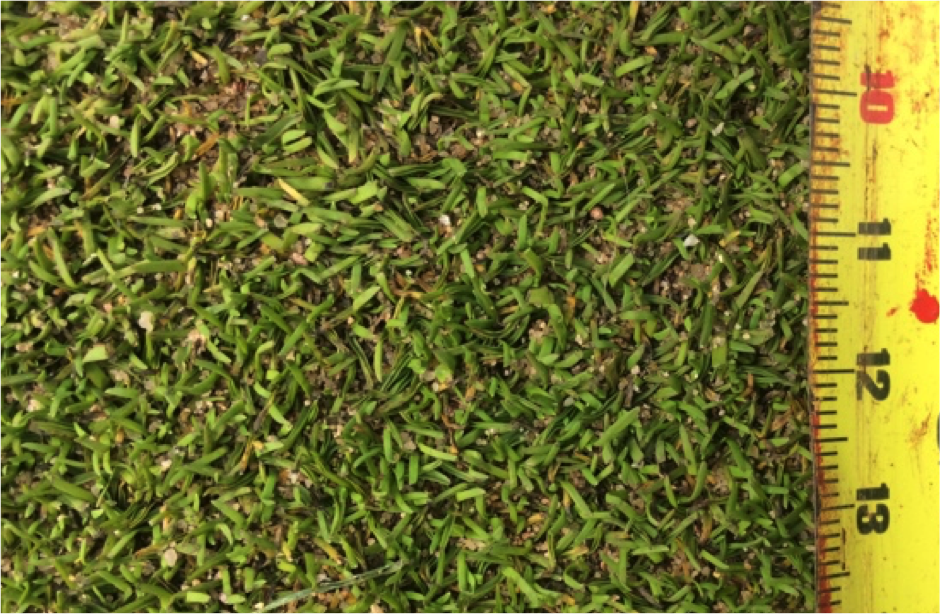
Ideal density for a poa annua dominated sward in main playing season – avoid overly lush and dense
‘We want them faster’
Most clubs will already be achieving over nine feet for summer competitions, which is plenty fast enough, especially if you have undulating or sloping greens. Higher speeds become very challenging and even unenjoyable for the average player. Bear in mind that every foot on the Stimpmeter adds 15 minutes to a round of golf so significantly slowing the speed of play. This doesn’t help the game at a time when participation is under pressure due to the time it takes to play.
Furthermore, managing greens for exceptionally high speeds requires significantly higher inputs in terms of manpower and material costs such as fertiliser, water, fungicide, growth regulator and so on. This is distinctly at odds with the sustainability movement that is gaining strength in all industries, including ours.
Let’s get real
The ‘Stimpmeter Chart’ image gives a guideline of what is realistically achievable / desirable during the main playing season. For soil-based greens, drainage may need to be considered to extend your ‘good’ playing season into the spring and autumn.
Are you making a rod for your own back?
Don’t be tempted to generate speeds above the target.
All too often this is the case; greens may be running within the target range and then a further cut or roll is implemented to take values above the target.
The golfer plays on these one day and then the next day, when the greens are back in the routine target, there are complaints of them being slow as the players have compared them to surfaces that were faster the day before. If ball roll quality is at an ideal level, don’t be afraid to do nothing further to the surface – that is the true meaning of sustainable greenkeeping.
Other top tips
- Rather than making faster speeds even faster, work on improving average green speed by bringing lowest speeds up, aiming for consistency of speed both between greens, throughout the day and over time.
- Understand the requirements of individual greens and implement green specific action to those that are naturally slower and do less to those that are naturally faster.
- Avoid unnecessary treatments to the naturally faster greens as this will only increase the discrepancy between the slower and faster surfaces.
- Manage growth, sward density and vigour with careful nutrient and water inputs to maintain consistency over the day.
- Understand that the effect of the roller wanes during the day. Use it to provide a polish only, rather than a routine treatment.
- Aim to set a reasonable speed target, which is sustainable to achieve, say between nine feet and nine feet six inches for routine summer play. At these speeds, it is enjoyable and sufficiently challenging for all categories of player, whereby the ball is rolling out under its own weight and it requires relatively minimal input to achieve.
- Stick to your target. Monitor regularly to inform daily decision making with morning set-up operations.
Summary
Set a sustainable green speed target and implement greenkeeping operations to deliver the target on a consistent basis and take great care to avoid exceeding the routine target.
Stella Rixon is a consultant for the STRI

























